Fifty-nine percent of HR leaders say that building critical skills or competencies is a top priority for their organization. However, 40 percent HR leaders say they can’t build skill development solutions fast enough to meet evolving skill needs as per Gartner reports.
As skill needs shift more rapidly due to digitalization, CEOs and CHROs are overwhelmingly asking talent managers and learning and development leaders to upskill or reskill employees as quickly and effectively as possible. In an increasingly automated and evolving job market, there’s significant pressure on employees to learn the right skills. Identifying which skills are right and what skills will make our workforce competitive now and in the future is the need of the hour. This is an opportunity for talent and L&D leaders to build a data driven organization for bigger impact for their talent development and learning investments.
In today’s job market, job titles are out, and skill sets are in. Skills preparedness is a critical measure to consider when determining how employees are keeping pace with shifting skill needs.
This article focuses on tools and technologies that talent and L&D leaders can use for enabling talent development and learning to understand the current learning capability of their organization and skills that are needed to move them ahead. It provides them with a structured framework of an analytics engine to Acquire, Apply and Activate the right learning through the right tools to target and drive a positive change in learning experience. At each step, the framework is enabled by technology to drive engagement and measure the effectiveness of the steps performed.
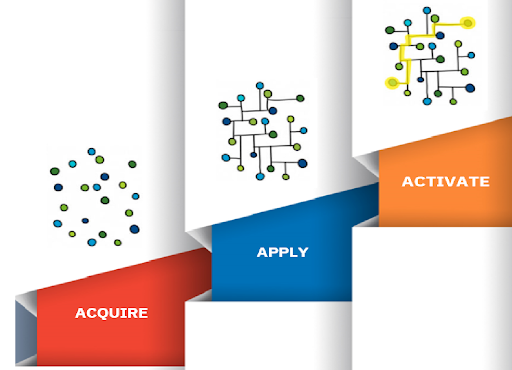
This article is intended for the learning and talent development and optimization unit of an organization, and would help the L&D department and CHROs to assess the effectiveness of learning programs. We will share a detailed view of the phases as well as the proposed implementation strategy — reduction to practice — to help build the right tools and technologies for enabling talent development and learning.
Framework Description
When it comes to learning, we realize that one size never fits all. The key elements of talent development focus on:
- Who we train.
- What we train them on.
- How we train them.
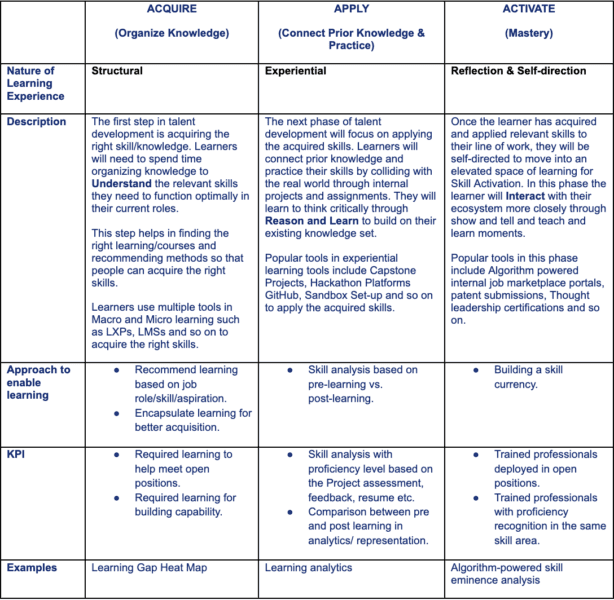
The basis of our Acquire, Apply and Activate framework is also built to respect this criterion. The structure of our optimal approach consists of:
Framework Step 1: Acquire
In the first step of talent development, learners will need to spend time organizing knowledge to understand the relevant skills they need to function optimally in their current roles. The key performance indicators that this step supports for an organization are:
- Required learning to help meet open positions.
- Required learning for building capability.
The driving questions in the Acquire phase are: How do you identify the right skills and learning needed? And, how do you help learners learn faster?
We propose an AI-based solution for recommending learning based on skills, job roles and aspirations irrespective of the mode of learning. It could be mandatory learning required for specific job band levels, job roles or learning needed for capability building based on the market demand.
The system proposed provides an approach for recommending learning to the users. The system can also propose learning based on identified skill gaps or job roles that the employee is performing and many more. Another aspect that the system captures is a mechanism through which learning can be put in a comprehensive manner for better consumption of the learner. The proposal is to provide a system with the following components with the following responsibility.
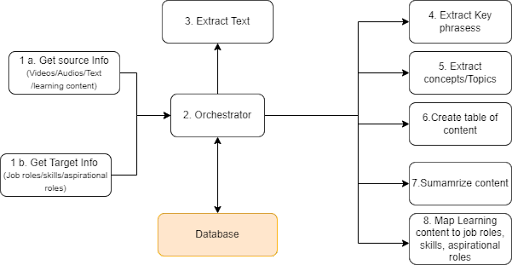
Here’s a brief view of how this system is built to work:
- The system proposes an implementation to read two types of content from respective repositories.
- Source content or learning content. Example: Content that can be used for learning text/video/audio/media files/learning proprietary content files.
- Target content or content for which the learning is recommended. Example: Job roles/skills/aspirational roles/any other custom target. A small description about the job role/skill/aspirational role/custom target is expected to better describe the content.
This could be implemented using a standard programming language to read files irrespective of their medium type described in 1a and 1b above from physical systems.
- The orchestrator is a component that would control different technical components in the system and help in choreographing various steps. Example: If the user intends to recommend learning, then the orchestrator would focus on a step to extract text from sources described in 1a and 1b and then invoke an AI based similarity service (Refer to step 8) to map the extracted text from source 1a to target 1b.
- The system here is responsible for the extraction of raw text leveraging a mix of programming techniques. Example: If the content is in PDF format, the system would implement a method to extract text from PDF files. If the content is in image format, the system would implement a method consisting of optical character recognition to extract text from images. If it is a video, it can extract text from both audio element and screen using a mix of speech-to-text and OCR techniques.
- The text pulled from step 3 is further leveraged to extract key phrases using AI-based natural language processing techniques to extract phrases that contain the core idea in the learning content defined in 1a. These tags are also used for tagging the content for better access. Example: The key phrases can be used to bookmark videos. Bookmark pdfs.
- The extracted text in step 3 is further leveraged to extract concepts or key topics present in 1a using AI based natural language processing techniques. The concepts or topics present can help in creating a table of content and provide an idea about the key concepts described in 1a. These concepts can also be extended further to tag content, especially which pages describe the concept or in what timestamps this concept is presented, helping ease learning for users.
- The system proposes a method to create a table of content for the content captured in 1a. Here, the system leverages a combination of info captured in step 5 and manual capture of information Example: The PDF headers or PPT headers. Using a technique of AI-based ranking shortens and summarizes the topics present in the content, which helps learners explore learning content better.
- Finally, using natural language generation techniques, the system creates a summary of information presented in 1a.
- Here, the system proposes an approach of recommending learning by matching extracted text (Refer to step 3) for 1a with 1b. The higher the semantic similarity, the better the matching.
For each of the steps in 3-8, the content goes through a process of pre-processing techniques consisting of either zero or many of the techniques, such as tokenization, lower-casing, word removal, stemming and lemmatization.
Framework Step 2: Apply
The next phase of talent development will focus on applying the acquired skills to perform optimally in the current role. Learners will connect prior knowledge and practice their skills by colliding with the real world through internal projects and assignments. They will learn to think critically through reasoning and learning to build on their existing knowledge set.
This step tries to meet the following key KPIs for an organization:
- Skill analysis with proficiency level based on the Project assessment, feedback, resume etc.
- Comparative analytics between pre and post-learning.
The driving questions in the Apply phase are: Has the learner applied the learning? And, how do you measure whether the learning has helped the learner to improve performance?
All learners share a common goal to develop more knowledge and learn new skills to put into practice whenever necessary. Our proposal is an AI-based approach for analyzing the impact of learning. It will be a method for analyzing the skills of the learner pre-learning versus post-learning.
The system crafts an approach to provide a comparison of skills related to learning between the pre-learning and post-learning. The proposal is to provide a system with the following components with the following responsibility. This helps us identify the impact of the training and the possible trajectory it will take for learners.
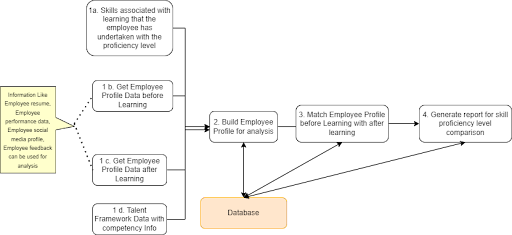
Here’s a brief view of how the system is built to work:
- The system proposes an implementation to read three types of information related to the employee and learning:
- The skill proficiency level associated with learning that the employee has undertaken.
- Employee profile related information with employee consent before learning such as employee resume, employee social media professional profile data (optional), employee feedback from manager, from peers (optional) and employee project assessment information (optional) to help understand the skill proficiency of the employee.
- Employee profile-related information with employee consent after learning such as an employee resume, employee social media professional profile data (optional), employee feedback from manager from peers (optional) and employee project assessment information (optional) to help understand the skill proficiency of the employee.
- A standard talent framework used in the organization which would contain information about competency and proficiency level. If a talent framework is not available as part of the organization a publicly available framework can be used.
- The system proposes a method to extract skills information with proficiency level to understand the skill of the employee. Here the text is extracted using text processing techniques for source 1-1b and source 2 -1c. Similarly, the text is extracted for a combination of competency and profile information from source 3-1c i.e., if a talent framework contains 200 competencies and there are four proficiency levels, then the system would produce 200 multiplied by four, i.e., 800 competency with proficiency level combinations. Further, the text for 1b is matched against the output 1c to build a profile of an employee which contains a unique combination of competency and proficiency information. In the profile the competency appears only once using the best matched proficiency level. The same concept is applied to the text extracted for 1c.
- Here, the system compares the output of step 2 for 1b and 1c using a rule-based mechanism to identify the changes in the competency proficiency level.
- Finally, here, the system maps the changes and highlights the one which matches with the input 1a, identifying potential changes in the proficiency level due to the learning. Further, it can also compare between the job role band levels, or across job roles to understand if learning had an impact on the employee’s skills.
Framework Step 3: Activate
Once the learner has acquired and applied relevant skills to their line of work, they will be self-directed to move into an elevated space of learning for Skill Activation. In this phase, the learner will interact with their ecosystem more closely through show and tell and teach and learn moments. This is evident from various aspects that can be collected for the learner such as eminence, badges/certifications to name a few. This step tries to meet the following key KPIs for an organization.
- Trained professionals deployed in open positions.
- Trained professionals with a proficiency recognition in the same skill area.
The driving questions in the Activate phase are: What is the new skill currency of the learner? And, are learners able to teach their new knowledge, skills or attitudes to other learners?
At this stage, we need to understand the eminence of the person after they have gone through the Acquire and Apply phase. Our proposal is an AI-based method for analyzing effectiveness of the learning for the learner through plotting a skill currency using multiple sources of information, such as a social media profile, badges acquired or training provided.
The proposal is to provide a system that recognizes the person has acquired necessary skills and has activated through social eminence, imparting skills to others, excelling in job roles and so on. The system computes a skill currency that can further be used to understand the employee’s mastery over the skill. The data that the system analyzes are badges earned, publications in internal/external forums and teaching impacted.
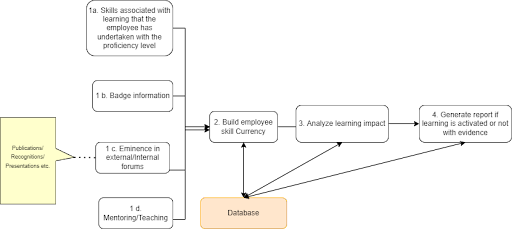
Here’s a brief view of how the system is built to work:
The proposal is to provide a system with the following components with the following responsibility.
- The system proposes an implementation to read four types of information related to the employee and learning.
- The skill proficiency level associated with learning that the employee has undertaken.
- Employee badge/certification related information if available. It should be noted that this information can also be built from employees’ resumes if not explicitly available using an AI-based named entity recognition technique.
- Employee eminence in external or internal forums based on information available in a resume or social profile.
- Employee experience in mentoring or teaching, which can be collected from peer-review, manager-review or self-review.
- The system proposes a method to build skill currency for employees that captures the badges and certificates, eminence in external or internal forums, teaching or mentoring or any other activity that can establish employee’s mastery to the subject related to the skill aligned with their learning.
- Further, the system proposes a method to establish the application of the skill in the activities that they undertook. This could be simple and business rules-based, such as date on which the training taken versus the date on which badges earned or presented in an external forum, or feedback received etc.
- Finally, based on the output of step 4, the system determines whether learning is activated or not based on SME-driven criterions.
Conclusion
As skills emerge, evolve and expire, talent developers and L&D leaders like us play a critical role in boosting employee skills preparedness.
We must strive to connect employees to the market by understanding emerging skill needs, make connections between employees’ own personal interests and organizational skill needs and connect employees to the right development experiences within or outside their organizations.















